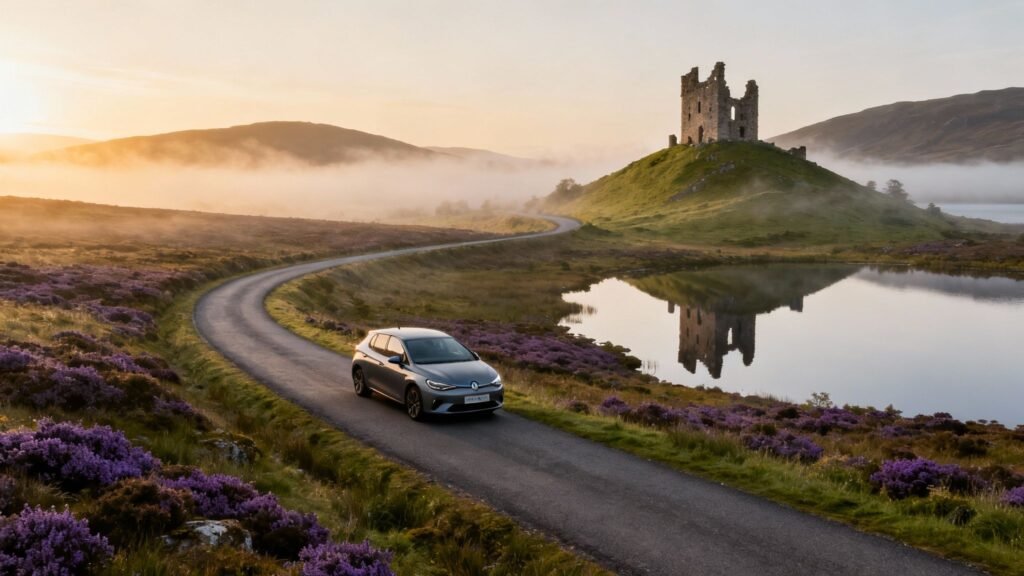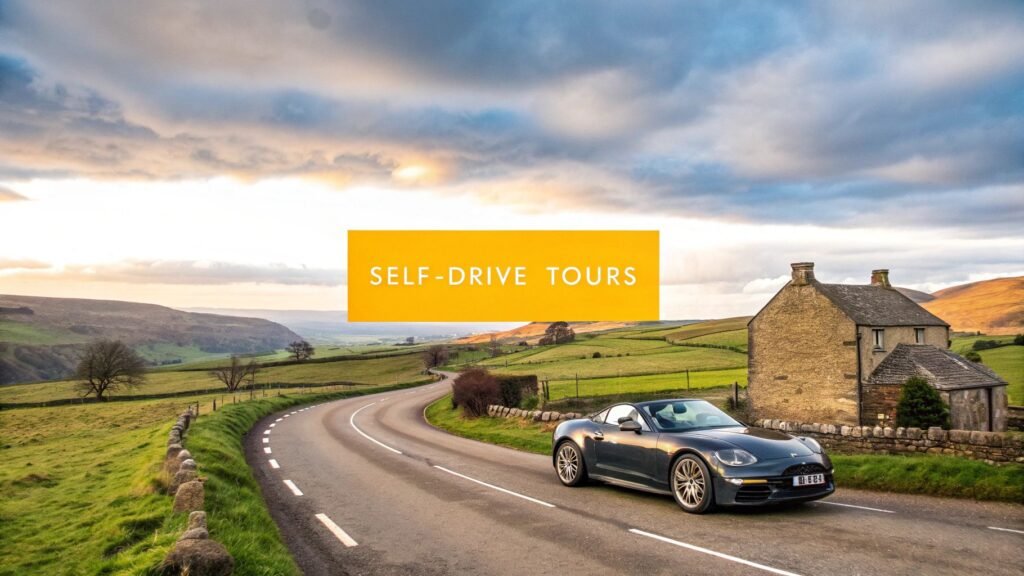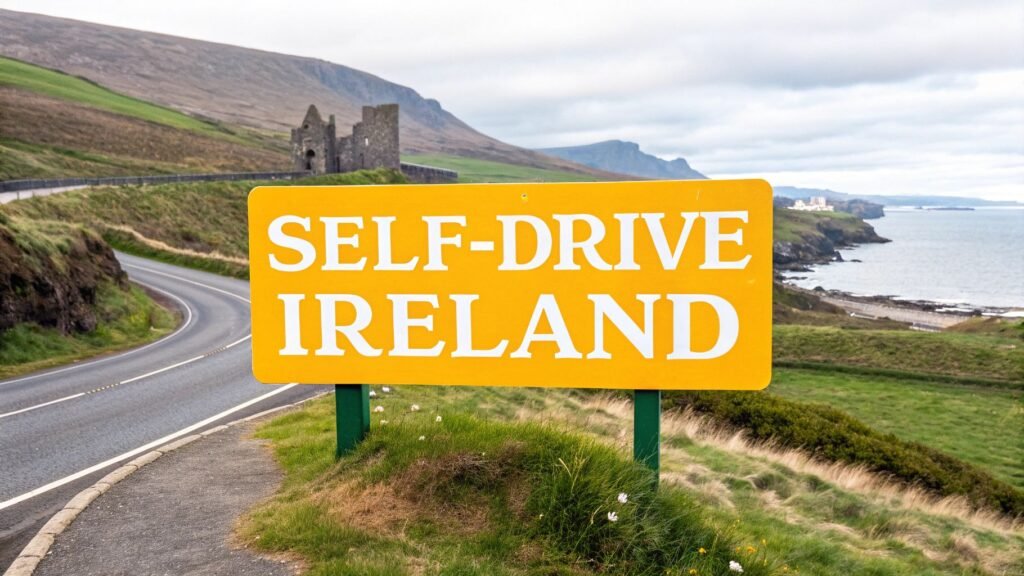So, you’re thinking about a Scotland Highland tour. Brilliant. Getting behind the wheel and exploring at your own pace is, without a doubt, the best way to soak in the raw beauty of this legendary landscape. It’s an adventure filled with dramatic scenery, crumbling castles, and the freedom to go wherever the road takes you.
Your Perfect Highland Adventure Starts Here
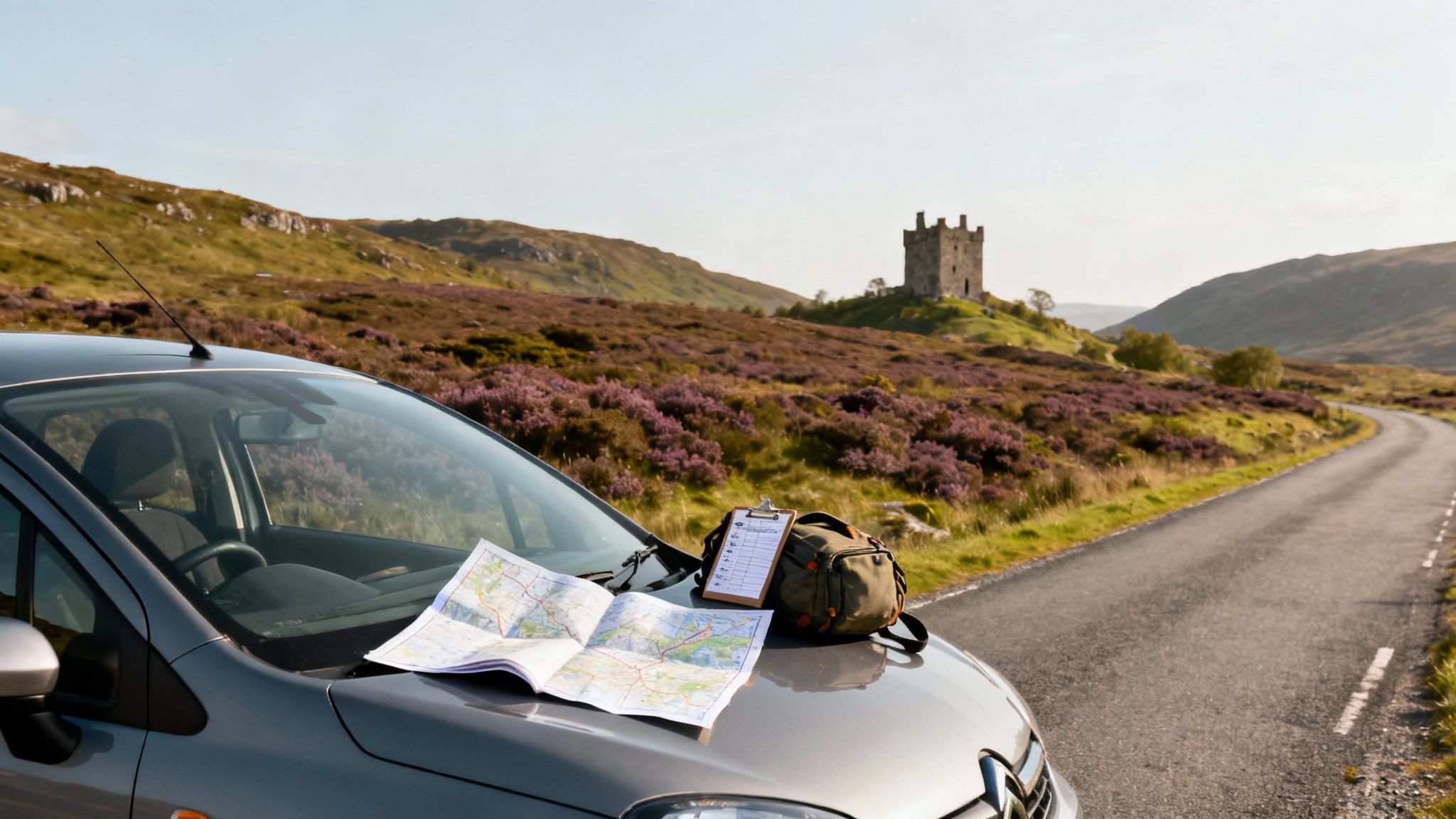
A self-drive tour of the Highlands isn't about ticking off a list; it’s about embracing the spirit of discovery. Forget rigid schedules and tour buses. With your own car, you can chase a sunset down a single-track road, linger for an hour at a viewpoint that speaks to you, or find a hidden glen that isn't in any guidebook. You're not just a tourist; you're an explorer.
The real magic lies in crafting an itinerary that’s entirely your own. Will you spend the day walking the solemn grounds of Culloden Battlefield? Perhaps you’ll take a boat out on Loch Ness, eyes peeled for Nessie. Or maybe you'll lose yourself in the otherworldly landscapes of the Isle of Skye. Think of this guide as your trusted co-pilot, here to give you the essential know-how and insider tips to build your perfect journey.
Key Planning Considerations
Before you start dreaming of open roads, a little bit of planning goes a very long way. The trick is to strike a balance between your must-see landmarks and the practicalities of driving times and accommodation, especially if you’re travelling in the busier months. Nailing down a few core elements first will make the whole trip run smoothly.
To get the ball rolling, have a think about these fundamentals:
- Best Time to Visit: Late spring (May-June) is a personal favourite—long days and fewer midges. Autumn (September-October) is a close second, with incredible colours. Summer is glorious but be prepared for crowds.
- Trip Duration: Give yourself at least 5-7 days to cover the highlights without feeling rushed. If you can stretch to 10 days, you can properly delve into places like the Isle of Skye or the Outer Hebrides.
- Route Planning: What’s your focus? Are you drawn to the epic coastal route of the NC500, or is your ideal trip a trail of ancient castles and world-class whisky distilleries?
- Accommodation: Book well ahead of time! Popular spots like Portree, Fort William, and anywhere along the NC500 can get booked up months in advance. You'll find everything from cosy B&Bs to grand hotels.
Getting these basics sorted helps shape a realistic and, most importantly, enjoyable trip. For a bit more inspiration, take a look at our full range of self-drive tours in Scotland to find a route that feels right for you.
A self-drive tour isn’t just about the destinations; it’s about the moments in between—the unplanned stops, the local pub lunches, and the breathtaking views that appear around every bend.
To help you get started, here's a quick-start planner to break down the key decisions for your Highland tour.
Highland Tour At-a-Glance Planner
This table summarises the most important factors to help you begin planning your self-drive tour.
| Planning Aspect | Recommendation | Key Consideration |
|---|---|---|
| Ideal Season | May-June & Sep-Oct | Weather is milder, fewer midges, and less crowded than July-August. |
| Trip Length | 7-10 Days | Allows for a relaxed pace and covers major regions without rushing. |
| Rental Car | Compact to Mid-Size | Easier to navigate narrow single-track roads and find parking. |
| Key Route | North Coast 500 or Classic Loop | Choose based on interest in coastal scenery versus historic landmarks. |
| Booking Lead Time | 3-6 Months Ahead | Crucial for securing good accommodation, especially on the Isle of Skye. |
With these points in mind, you're already on the right track to planning a truly unforgettable road trip.
Why the Highlands Capture the Imagination
There’s a reason a Scotland Highland tour feels less like a holiday and more like stepping into another world. It’s a journey into a landscape that feels ancient, alive, and utterly wild. The Highlands have a rare quality that pulls you in, a connection to something primal and untamed that’s hard to find anywhere else. Every glen, loch, and mountain here has a story to tell, etched right into the land itself.
This isn't a landscape of gentle, rolling hills. It’s a place of dramatic, often moody, contrasts. One moment, dark clouds sweep over vast, empty moors; the next, a burst of sunshine sets a loch shimmering like a jewel. The sheer scale of it all—from the haunting, cathedral-like valley of Glencoe to the jagged peaks of the Cuillins on Skye—is enough to take your breath away. You stop just being an observer and start feeling like a small part of something immense.
A Destination on the Rise
That powerful magnetic pull isn't just a romantic idea; the numbers back it up. For years, travellers have been drawn to this unique blend of raw nature and deep history, and that interest has exploded recently. The Highlands are now a cornerstone of Scotland's tourism economy, attracting visitors from all over the globe.
Just how popular has it become? Data from VisitScotland and the Highland Council shows visitor numbers soared from roughly 5.1 million in 2012 to 8.4 million in 2023. That's a staggering 64.7% increase in just over a decade. This surge has made the Highlands the third most visited region in Scotland, a testament to its powerful and growing allure. You can dive deeper into the data in the Highland Council's sustainable tourism strategy.
The good news is that this popularity means that while the wilderness still feels untouched, the infrastructure to support a fantastic trip is better than ever.
The Irresistible Blend of Culture and Wilderness
What truly sets the Highlands apart is how its dramatic landscapes are tangled up with a rich, living culture. This isn't some static, museum-like place. Here, ancient castles stand guard over shimmering lochs, and centuries-old stories of clans, bloody battles, and folklore feel like they happened just yesterday.
A trip through the Highlands is like stepping into a living storybook. The past isn't just in textbooks; it whispers from the standing stones at Clava Cairns and echoes across the solemn battlefield of Culloden.
Your own Scotland Highland tour is a chance to experience this unique fusion for yourself. You can:
- Explore Historic Fortresses: Stand on the battlements of Eilean Donan Castle and just try not to imagine the lives of those who defended it for centuries.
- Trace Clan Histories: Uncover the poignant stories of loyalty and betrayal that shaped the region, from the MacDonalds of Glencoe to the MacKenzies of Kintail.
- Experience Gaelic Culture: Hear the lyrical sounds of Gaelic music spill out of a local pub or learn about traditions that have been passed down for generations.
In many destinations, nature and culture are two separate things you go to see. In the Highlands, they are one and the same. It’s this deep, unbreakable connection that turns a simple road trip into something truly memorable. While the grand architecture of cities like Edinburgh offers its own kind of magic—as you can see in our guide on why it’s known as the Athens of the North—the Highlands immerse you in Scotland's wild heart. It's an adventure that stays with you long after you've come home.
Designing Your Ideal Self-Drive Itinerary
The best part of a self-drive tour through the Scottish Highlands is the sheer freedom of it all. You're not just following a pin on a map; you're the master of your own adventure. You set the pace. Fancy spending an extra hour watching the mist roll over a glen? Go for it. Want to make an impromptu detour down a winding single-track road that looks promising? That’s what this is all about.
To get your imagination going, I’ve sketched out three popular route ideas. Think of them as starting points, not strict rules. Each one offers a different taste of the Highlands, ready for you to tweak, combine, or completely reshape to fit your own travel dreams. Whether you're chasing iconic lochs, dramatic coastlines, or the perfect dram of single malt, your ideal route is waiting to be discovered.
This handy decision tree can point you in the right direction if you're not sure where to start.
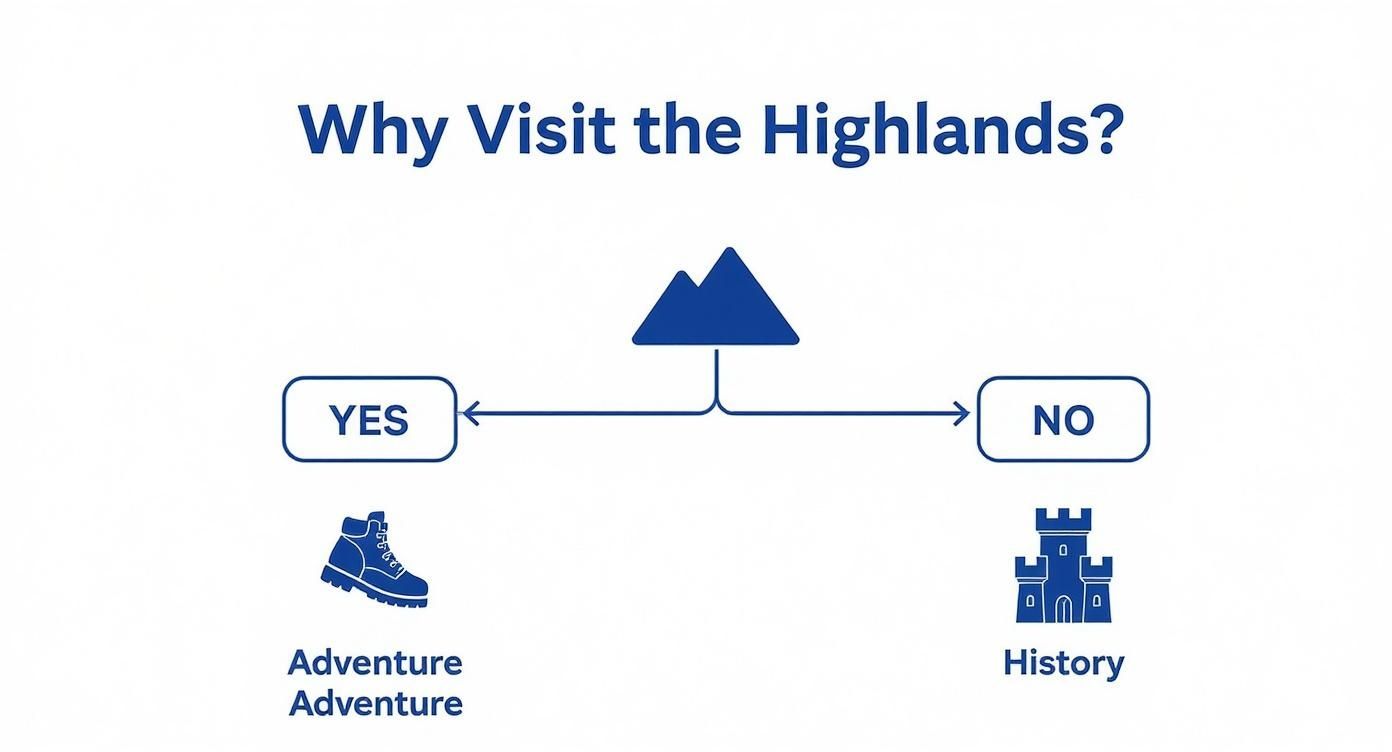
As you can see, whether you're drawn by the promise of breathtaking landscapes or a deep dive into Scotland's rich history, there's a path waiting for you.
The Classic Loop Through Scotland's Heart
If you're visiting for the first time, this is the quintessential Highland experience. It's a journey through the very soul of Scotland, hitting all those legendary spots that have captivated travellers for generations. You'll get a brilliant mix of staggering landscapes and key historical sites.
Here’s what a typical 5-day trip might look like:
- Day 1 Inverness & Loch Ness: Kick things off in Inverness, the Capital of the Highlands. Spend the afternoon on a boat cruise across the vast, mysterious Loch Ness. Keep your camera ready for Nessie and be sure to explore the atmospheric ruins of Urquhart Castle on its banks.
- Day 2 Culloden & Clava Cairns: A day for time travel. Stand on the windswept moor of Culloden Battlefield and feel the weight of history from the final Jacobite rising. A stone's throw away are the Clava Cairns, an incredibly well-preserved and enigmatic Bronze Age burial site.
- Day 3 Glencoe & Fort William: Head south through the Great Glen to witness the raw, jaw-dropping beauty of Glencoe. Carved by ancient glaciers and steeped in tragic history, this valley is a photographer’s paradise. Your day ends in Fort William, tucked in the shadow of Ben Nevis, the UK's highest peak.
- Day 4 The Road to the Isles: Take the stunning A830 towards Mallaig, making a crucial stop at the Glenfinnan Viaduct (yes, the one from Harry Potter!). The panoramic views across Loch Shiel from the visitor centre are simply unforgettable.
- Day 5 Stirling Castle & Return: As you head back towards Edinburgh or Glasgow, break up the journey at Stirling Castle. This imposing fortress was once the key to the kingdom and is one of Scotland’s most historically significant sites.
This route gives you a perfect balance of driving and sightseeing, so you can soak in all the big-ticket locations without feeling rushed off your feet.
The Coastal Explorer The North Coast 500
Often called Scotland's answer to Route 66, the North Coast 500 (NC500) is an epic 516-mile road trip that hugs the rugged, wild coastline of the far north. This one's for the true adventurer—someone who craves untamed beauty, towering sea cliffs, and secluded white-sand beaches that look like they belong in the Caribbean (though the water temperature tells a different story!).
The NC500 isn’t just a drive; it's a full-on immersion into the remote and breathtakingly beautiful edges of Scotland. Every single bend in the road opens up a new vista, from dramatic sea stacks to quiet, hidden coves.
To do it justice, you’ll want to set aside at least 7-8 days. The highlights come thick and fast:
- Bealach na Bà: A legendary single-track mountain pass with heart-in-mouth hairpin bends and views that will leave you speechless. It’s not for the faint-hearted!
- Applecross Peninsula: A wonderfully remote area that feels like you've reached the edge of the world. The sense of peace here is incredible.
- Ullapool: A picturesque fishing village that serves as a fantastic base for exploring the wild northwest.
- Duncansby Head: Stand at the most north-easterly point of the British mainland and marvel at the colossal sea stacks and the colonies of seabirds.
- Smoo Cave: A massive sea and freshwater cave near Durness that you can explore by boat for a truly unique experience.
The NC500 requires a bit more planning for things like accommodation and fuel, but the payoff is an unforgettable journey into Scotland's wild heart.
The Whisky and Castles Trail
For those who love a good story, a dram of fine whisky, and the romance of ancient castles, this route is a dream come true. It meanders through the Speyside region—the undisputed heartland of Scotch whisky—and connects some of the nation's most magnificent fortresses.
This journey is best enjoyed at a more relaxed pace. For a perfectly structured experience, our Taste of Scotland 8 Days Self Drive Tour is a fantastic option that blends distillery tours with castle visits.
On this trail, you'll get to experience:
- The Malt Whisky Trail: A collection of world-renowned distilleries in Speyside, including giants like Glenfiddich, Glenlivet, and Macallan. Most offer fantastic behind-the-scenes tours and tastings.
- Eilean Donan Castle: Quite possibly the most photographed castle in all of Scotland, perched perfectly where three great sea lochs meet. It’s a truly iconic sight.
- Cawdor Castle: A fairytale castle with stunning gardens and a legendary (if not entirely factual) link to Shakespeare's Macbeth.
- Balmoral Castle: The Royal Family's beloved Scottish home. You can explore the grounds, gardens, and exhibitions when they are not in residence.
This itinerary is a true feast for the senses, where you can pair sublime scenery with the rich flavours and fascinating tales that make Scotland so special.
Choosing Your Ideal Highland Driving Route
Still weighing your options? This table breaks down the three routes to help you find the one that calls to you the most.
| Route Name | Best For | Typical Duration | Key Highlights |
|---|---|---|---|
| The Classic Loop | First-time visitors and history buffs. | 4-6 Days | Loch Ness, Glencoe, Culloden Battlefield, Glenfinnan Viaduct. |
| The Coastal Explorer | Adventurous drivers and nature lovers. | 7-10 Days | NC500 route, Bealach na Bà, sea stacks, remote beaches. |
| The Whisky & Castles Trail | Foodies, history enthusiasts, whisky fans. | 5-8 Days | Speyside distilleries, Eilean Donan Castle, Balmoral Castle. |
Ultimately, the right route is the one that excites you. Whether you stick to one of these or create your own hybrid adventure, you're in for the trip of a lifetime.
Securing the Best Highland Accommodations
Choosing where to rest your head each night is a massive part of what makes a Highland tour so special. The right accommodation isn’t just a bed for the night; it becomes a memorable part of the adventure itself—a cosy refuge after a day spent exploring windswept glens and ancient castles. Thankfully, the Highlands cater to every possible taste and budget, from rustic charm to modern comfort.
You'll find an incredible variety of places to stay. Just imagine waking up in a family-run Bed & Breakfast where the owner shares local secrets over a full Scottish breakfast. Or picture yourself unwinding by a crackling fire in a historic inn that has welcomed travellers for centuries. You could even have the total privacy of your own self-catering cottage, with breathtaking views over a serene loch.
Why Booking in Advance is Non-Negotiable
If there's one golden rule for Highland travel, it's this: plan ahead, especially when it comes to your accommodation. The region’s immense popularity means the best spots get snapped up months, not weeks, in advance. This is particularly true in hotspots like the Isle of Skye, Fort William, and the charming villages dotted along the North Coast 500.
Waiting until the last minute, especially during the peak season from May to September, almost always leads to disappointment or having to settle for somewhere that wasn't your first, second, or even third choice.
Booking your accommodation 3-6 months before your trip isn't just a good idea; it's absolutely essential for locking in the places you truly want to stay, and at a reasonable price. It gives you the best selection and saves you from a stressful, last-minute scramble.
This high demand is fuelled by the sheer number of visitors drawn to the region's raw beauty. The Scottish Highlands recently attracted an estimated 1.79 million overnight tourism visits, which generated a massive total spend of £756 million. Domestic travellers from within the UK accounted for over 1.2 million of these visits alone, which just goes to show how popular this destination is.
A Spectrum of Highland Stays
One of the real joys of a self-drive tour is the freedom to mix and match your accommodations to suit your itinerary and mood. Getting to know your options is the first step in crafting a comfortable and authentic trip.
- Bed & Breakfasts (B&Bs): These are the heart and soul of Highland hospitality. B&Bs offer that personal touch, with hosts who are often fantastic sources of local knowledge. They provide a cosy, home-away-from-home feeling that's hard to beat.
- Historic Inns and Pubs: For a truly immersive experience, why not stay in an inn that's steeped in history? These places often feature a traditional pub downstairs, perfect for enjoying a hearty meal and a local ale after a long day on the road.
- Self-Catering Cottages: Ideal for families, groups, or anyone craving a bit more independence. Renting a cottage gives you the freedom to cook your own meals and create a private base for exploring a specific area for a few days.
- Grand Hotels: If you’re looking to sprinkle a little luxury into your tour, the Highlands boast some magnificent country house hotels. These often come with fine dining restaurants, sprawling grounds, and impeccable service.
To make sure you pick a real gem, it helps to know what separates good hospitality from great. Reading up on the strategies for creating the best guest service experience can give you an eye for spotting the hallmarks of a fantastic B&B or rental while you're browsing.
Don't Forget to Pre-Book Attractions, Too
That "book ahead" rule doesn't just apply to where you sleep. Many of the most popular attractions and experiences on a Scotland Highland tour also require advance booking to guarantee a spot, especially those with limited capacity.
Think about activities like:
- Distillery Tours: The world-famous distilleries, especially in Speyside, run small tour groups that often fill up weeks in advance.
- Boat Trips: Whether it's a cruise on Loch Ness or a wildlife-watching tour to see puffins and seals, these excursions have set departure times and a limited number of seats.
- Unique Experiences: Things like guided hikes, special historical site tours, or a trip on the Jacobite Steam Train (the "Hogwarts Express") are incredibly popular and absolutely must be booked well ahead of time.
Weaving these bookings into your planning process early on will ensure your itinerary runs smoothly. It lets you relax and soak in every moment of your Highland adventure without the nagging worry of missing out.
Driving and Exploring Like a Local
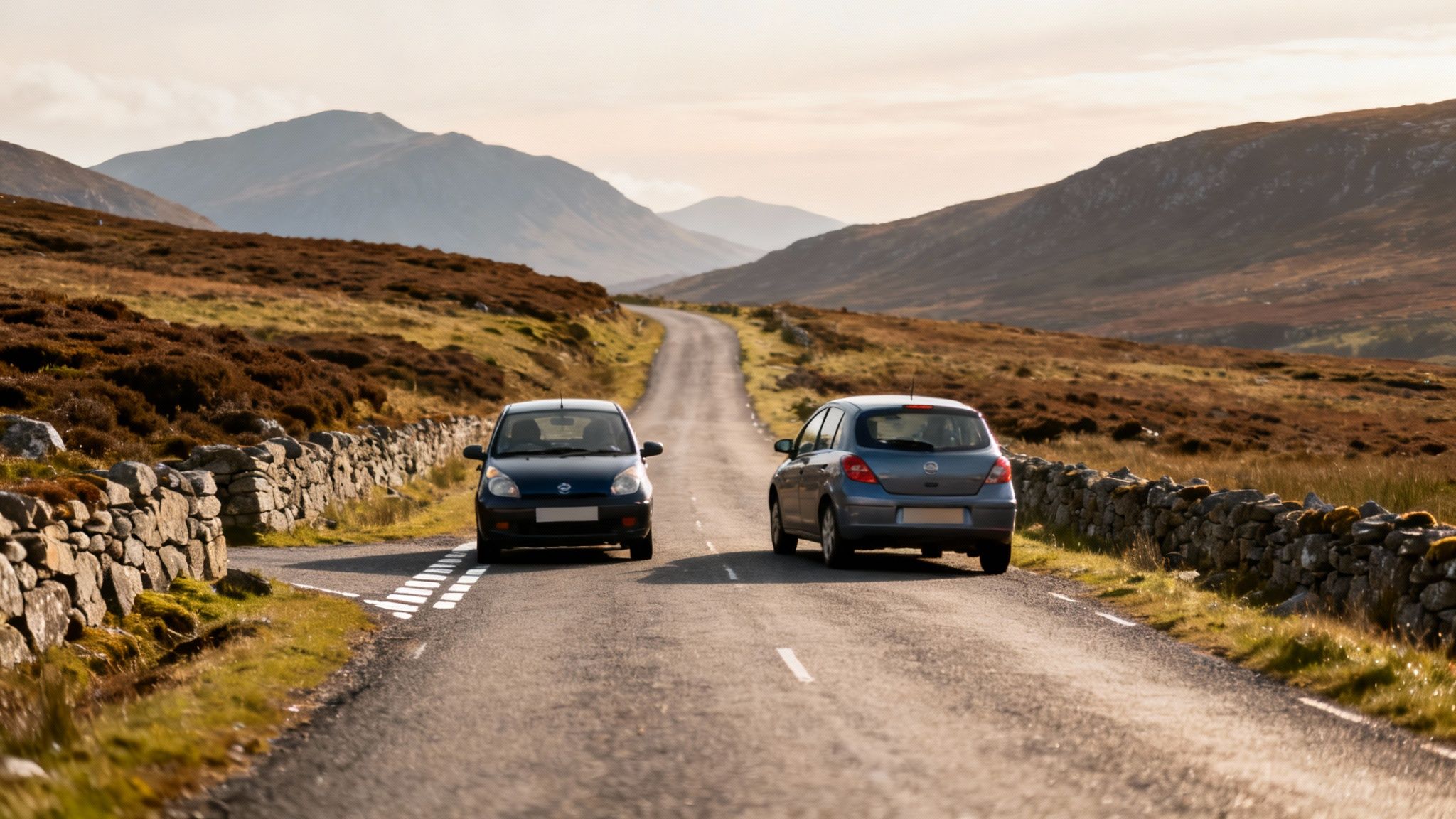
A truly great trip through the Highlands is about more than just ticking off the big sights. It's about sinking into the rhythm of the place, understanding the unique roads, and connecting with the communities that call this incredible landscape home. By embracing a few local ways of doing things, you can turn a good holiday into an unforgettable one.
The biggest learning curve for most visitors? The single-track road. These narrow lanes are the lifeblood of the Highlands, connecting tiny hamlets and revealing jaw-dropping views. They look intimidating, but they run on a simple system of common sense and courtesy.
It's all about give and take. These roads are dotted with passing places, which are small pull-outs designed to let cars get by one another. The unwritten rule is that whichever car is closer to a passing place on their left should pull in and let the oncoming traffic through. A quick, friendly wave is part of the deal—it's just how things are done.
Mastering Single-Track Roads
Getting the hang of these roads will make your journey so much more relaxed and enjoyable. This isn't a race; it's about being aware and patient. The trick is to always look far ahead to see what's coming.
Here's how the passing place dance works in practice:
- Spot an Oncoming Car: Keep your eyes peeled down the road. As soon as you see someone coming, look for the nearest passing place.
- Pull in on the Left: If the passing place is on your left, indicate and pull in fully, leaving plenty of room for the other car to pass you.
- Wait on the Right: If the nearest passing place is on your right, you should stop on your side of the road, directly opposite it. This allows the oncoming driver to swing into the passing place to get around you.
- Give a Thank-You Wave: A simple lift of the hand is the universal sign of thanks on these roads. It’s a small thing, but it keeps the friendly atmosphere alive.
Just remember never to park in a passing place. They’re essential for keeping traffic moving and are often the only access gates for farmers trying to get to their fields.
Becoming a Respectful Visitor
Beyond the tarmac, how you interact with the small Highland communities can make all the difference to your trip and to the people who live there. Being a thoughtful traveller means leaving a place as good as you found it, which is more important than ever as the Highlands grow in popularity.
This idea of mindful travel is becoming a bigger deal. A recent Visitor Trends Report from VisitScotland highlighted that more travellers are seeking out authentic heritage and pristine nature. People are actively looking for sustainable, responsible ways to explore. You can read more about these emerging Scottish tourism trends and see how they're shaping travel.
Being a responsible tourist isn't about grand gestures. It's about the small, thoughtful choices you make every day—where you shop, how you drive, and the respect you show for the land and its people.
Here are a few easy ways to make a positive impact:
- Support Local Businesses: Pop into the independent shops, family-run cafés, and local art galleries. Your money goes directly back into the community.
- Leave No Trace: This is a big one. The wild landscapes are precious, so always take your litter home with you.
- Be Patient and Kind: Life in the Highlands often moves at a slower pace. Embrace it! A little patience and a friendly smile go a very long way.
By adopting these simple habits, you're doing more than just seeing the Highlands—you're becoming part of its story. This deeper, more meaningful connection is at the heart of our self-drive tours, giving you the freedom to explore at your own pace, responsibly.
Final Questions Before Your Highland Road Trip
Planning a self-drive tour through the Scottish Highlands is thrilling, but it's natural to have a few last-minute questions buzzing around. Thinking about the weather, what car to hire, or even the infamous midges is all part of the process. Getting these practicalities sorted is the final step in turning a good plan into a great adventure.
Let's run through the common queries we hear from travellers. This is your final checklist before you hit the road, covering everything from the right set of wheels to staying connected (or not!), so you can set off feeling confident and ready for the wild heart of Scotland.
What’s the Best Car for Driving in the Highlands?
This might surprise you, but you don't need a massive 4×4. While it's easy to imagine tackling the terrain in a rugged off-roader, it's completely unnecessary for most trips. The vast majority of Highland roads, including the entire North Coast 500 route, are well-maintained tarmac.
A standard compact or mid-sized car is your best bet. A smaller vehicle is a huge advantage on the narrow, single-track roads you’ll inevitably encounter. It makes finding a spot in a tight village car park in Plockton or Portree so much easier. You’ll also be thankful for the better fuel efficiency, as petrol stations can be few and far between once you get into the more remote areas.
Unless you’re planning a winter trip where snow and ice are a real possibility, or you have specific off-road tracks in mind, save your money. Opt for comfort and economy over a vehicle with capabilities you just won't use. I'd also recommend an automatic—it lets you focus more on the jaw-dropping scenery and less on changing gears.
How Should I Prepare for Highland Weather?
There’s an old saying in Scotland: "If you don't like the weather, just wait five minutes." It’s less of a joke and more of a genuine forecast. The Highland weather is famously unpredictable and can turn on a sixpence. You can honestly get all four seasons in a single afternoon, from brilliant sunshine to driving rain and back again.
The secret to enjoying your trip, no matter what the sky is doing, is layering. Packing a versatile wardrobe is far more practical than relying on a single heavy coat.
Make sure these essentials are in your bag:
- A waterproof outer layer: A good quality waterproof and windproof jacket is absolutely non-negotiable.
- Warm mid-layers: Fleeces or a light down jacket are perfect for trapping heat and are easy to peel off when the sun makes an appearance.
- Breathable base layers: T-shirts and long-sleeved tops that wick moisture away will keep you comfortable.
- Sturdy, waterproof footwear: Whether you're a serious hiker or just planning short walks to viewpoints, dry and happy feet depend on comfortable, waterproof boots.
When you're prepared for anything, you're free to enjoy everything. A sudden downpour over Glencoe is just as dramatic and beautiful as a sunny afternoon on Skye—as long as you’re properly dressed for it.
Are the Midges Really That Bad?
Ah, the Scottish midge. This tiny insect has a reputation that punches well above its weight, but with a bit of foresight, it's more of a mild annoyance than a holiday-wrecker. Midges are most active in the summer months, usually from late May to early September.
They love calm, damp, and overcast conditions, and you'll find them at their worst at dawn and dusk, especially near still water like lochs. The good news? They absolutely hate wind and bright sunshine, two things the Highlands can provide in spades.
Here’s how to keep them at bay:
- Use a good repellent: Locals swear by products like Smidge or Avon Skin So Soft. Repellents containing DEET are also very effective.
- Cover up: Simply wearing long sleeves and trousers in the evening creates a physical barrier.
- Pack a head net: If you know you react badly to bites or you're planning to be out in the evening (perhaps fishing or camping), a midge head net is a godsend.
Honestly, most visitors find that with these simple steps, the midges are no big deal. Don't let the fear of a tiny fly put you off experiencing a magnificent Highland summer.
What’s the Mobile and Internet Coverage Like?
When you’re driving through the Highlands, it’s best to adopt a mindset of being selectively connected. In towns and larger villages like Inverness, Fort William, and Portree, you’ll find a reliable 4G signal and Wi-Fi in your hotel or the local cafes.
But once you head out into the remote glens and winding coastal roads, expect your signal to become patchy or disappear completely. This is part of the magic of really getting away from it all, but it does mean you need to plan ahead.
Crucially, download your maps for offline use before you set off each day. Apps like Google Maps let you save entire regions to your phone, so your navigation will work perfectly even when you have zero signal. It’s a simple trick that prevents that sinking feeling of being lost when you take an intriguing detour down an unmarked road. Think of it as a chance to unplug from the screen and plug into the incredible landscapes around you.
Ready to create your own unforgettable road trip? At BTOURS, we specialise in crafting personalised self-drive journeys that let you discover the magic of the Highlands at your own pace. Explore our curated itineraries and start planning your adventure today at https://www.btours.com.

